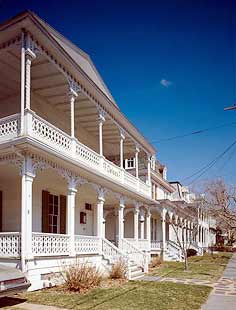
 |
||||||




Historic Preservation "Talk." What do our words really mean? Do you ever hear someone say they're "restoring" a historic building or landscape when they're really doing something else? The words used to describe work on historic places would seem fairly interchangeable, but there are important distinctions between Preservation, Rehabilitation, Restoration, and Reconstruction.
The importance of historic materials. American historic preservation philosophy puts a value on authenticity—"real" historic building materials and craftsmanship. When you choose a work approach, you are—in part—determining how much historic material will be left after work and how the building will be interpreted historically. In the absence of written, graphic, or spoken explanation, what we choose to repair, replace or demolish ultimately shapes how the property's history exists in time and is perceived by today's and tomorrow's viewers.
In The Secretary of the Interior's Standards for the Treatment of Historic Properties, the four treatment options—or approaches to work—were designed in a clear hierarchical framework, with Preservation as the preferred option.
 |
||
Preservation, the first treatment, places a high premium on the retention of all historic fabric through conservation, maintenance and repair. It reflects a property's continuum over time, and the respectful changes and alterations that are made through successive occupancies. |
||
Rehabilitation, the second treatment, also reflects a property's continuum over time. While emphasizing the retention and repair of historic materials, more latitude is provided for their replacement because it is assumed the property is more deteriorated prior to work. Alterations and additions for an updated use are acceptable. |
||
Restoration, the third treatment, focuses on the retention of materials from the most significant time in a property's history. It permits the removal of materials from all other periods. This treatment is generally selected for interpretive purposes. |
||
Reconstruction, the fourth treatment, establishes limited opportunities to re-create a non-surviving site, landscape, building, structure, or object in all new materials for interpretive purposes. It is rarely recommended. |
The choices we make. When choosing a
treatment, stop to ask yourself these questions: "How real will the
property be after my work?" "How much new material will be introduced?" "How much will be added or changed." "If I restore,
how much authentic historic material from later periods will be lost trying to recover the
original appearance?"
---------------------------------